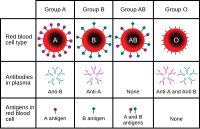
Photo from wikipedia
BACKGROUND Alloimmunization can be a significant barrier to red blood cell (RBC) transfusion. While alloantigen matching protocols hold promise in reducing alloantibody formation, transfusion-dependent patients can still experience RBC alloimmunization… Click to show full abstract
BACKGROUND Alloimmunization can be a significant barrier to red blood cell (RBC) transfusion. While alloantigen matching protocols hold promise in reducing alloantibody formation, transfusion-dependent patients can still experience RBC alloimmunization and associated complications even when matching protocols are employed. As a result, complementary strategies capable of actively preventing alloantibody formation following alloantigen exposure are warranted. STUDY DESIGN AND METHODS We examined whether pharmacological removal of macrophages using clodronate may provide an additional strategy to actively inhibit RBC alloimmunization using two preclinical models of RBC alloimmunization. To accomplish this, mice were treated with clodronate, followed by transfusion of RBCs expressing the HOD (HEL, OVA, and Duffy) or KEL antigens. On days 5 and 14 post transfusion, anti-HOD or anti-KEL IgM and IgG antibodies were evaluated. RESULTS Low dose clodronate effectively eliminated key marginal zone macrophage populations from the marginal sinus. Prior treatment with clodronate, but not empty liposomes, also significantly inhibited IgM and IgG anti-HOD alloantibody formation following transfusion of HOD RBCs. Similar exposure to clodronate inhibited IgM and IgG antibody formation following KEL RBC transfusion. CONCLUSIONS Clodronate can inhibit anti-HOD and anti-KEL antibody formation following RBC transfusion in preclinical models. These results suggest that clodronate may provide an alternative approach to actively inhibit or prevent the development of alloantibodies following RBC transfusion, although future studies will certainly be needed to fully explore this possibility.
Journal Title: Transfusion
Year Published: 2022
Link to full text (if available)
Share on Social Media: Sign Up to like & get
recommendations!